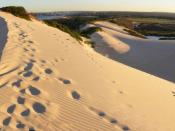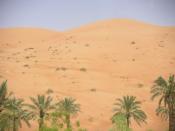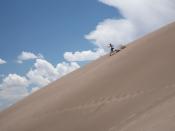1.0 Introduction
1.1 What are Sand Dunes?
McHenry [1] (1993, p. 406) states, "A sand dune is a hill, mound or ridge of accumulated sand and loose material, which is formed by wind action." They are natural structures that protect the coastal environment by absorbing energy from wind, tide and wave action.
1.2 Formation of Sand Dunes
Sand dunes are formed by accretion, which is the increase of land by the action of natural forces. Any part of the upper beach, once dry, can lose sand to the wind, especially if the sand is fine, and dune formation proceeds in the direction which the predominant wind direction is blowing.
As claimed by McHenry [2] (1993, p. 754) "Sand dunes are also formed as the wind carries sediment from the beach in a landward direction, depositing it wherever an obstacle obstructs airflow." The dune gradually grows in this way, creating a larger obstruction to sand particles being airborne.
With high wind speeds, sand is continually pushed over the crest of the primary dune. This causes new sand dunes to build up behind the first dune, eventually forming a series of dunes from the seashore, inland.
1.3 Succession and Zonation in Sand Dune Communities
Huxley and Walter (2000, p. 127) found that as a dune forms, "sand is unstable and tends to move with wind action." However, there are a few plants which are able to cope with these conditions, and these will begin to colonise the dune area, and plant succession will occur. Often these pioneer plants include Spinifex grass and creepers (Huxley & Walter 2000). These pioneer plants are very tolerant of salt and can therefore grow much closer to the sea than most other species. These plants may have adaptations that may include:
ç High vertical growth rates...


